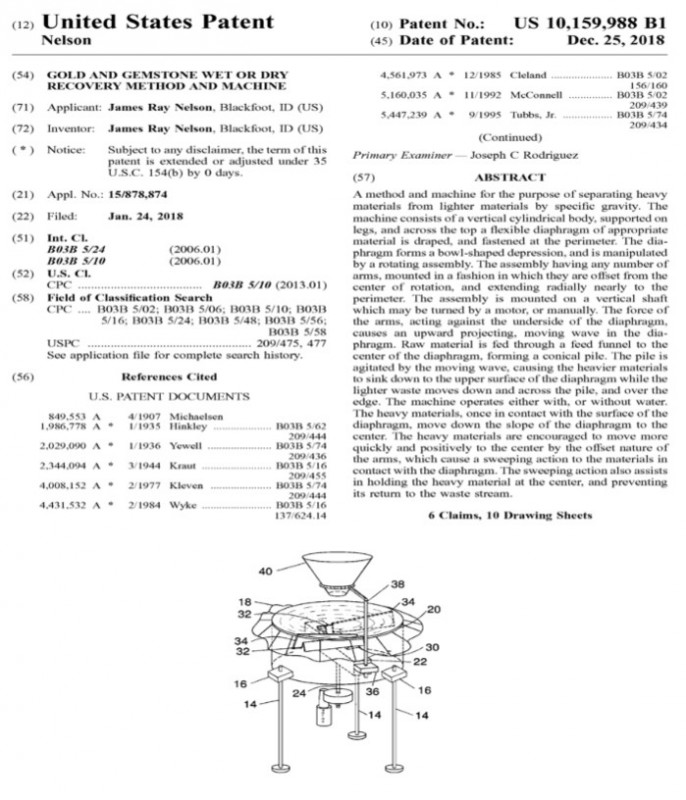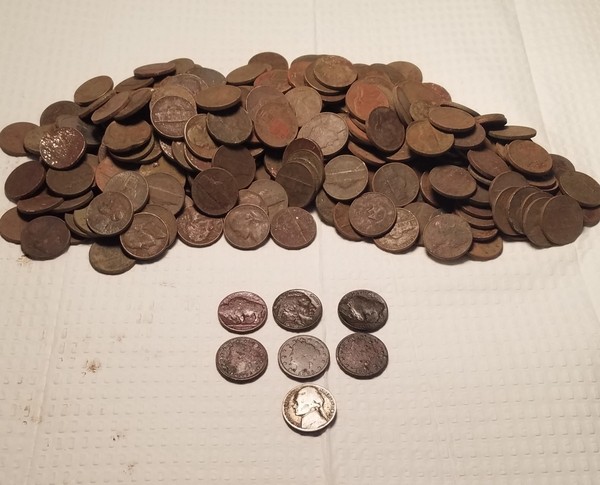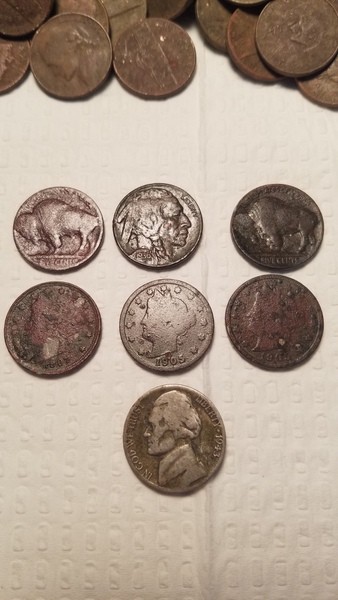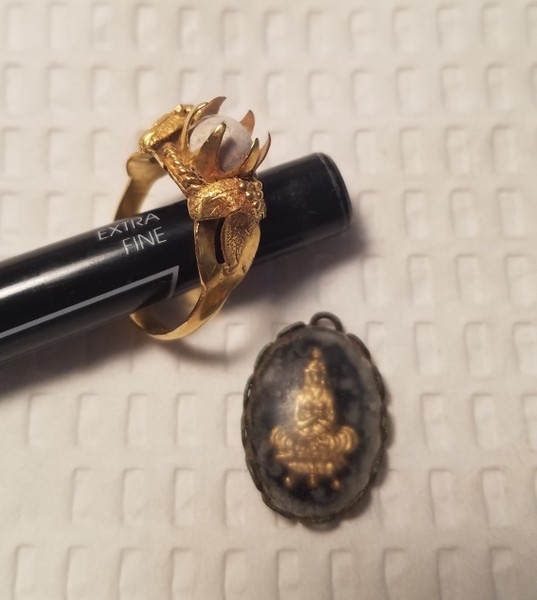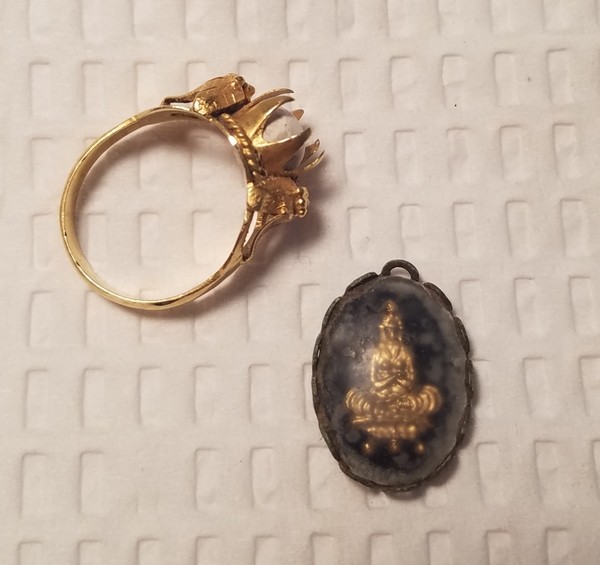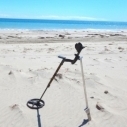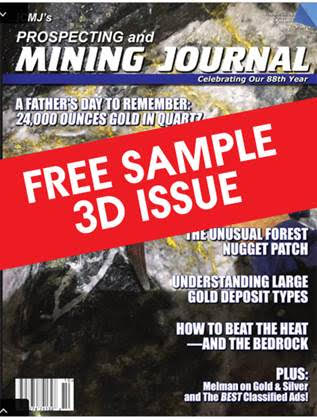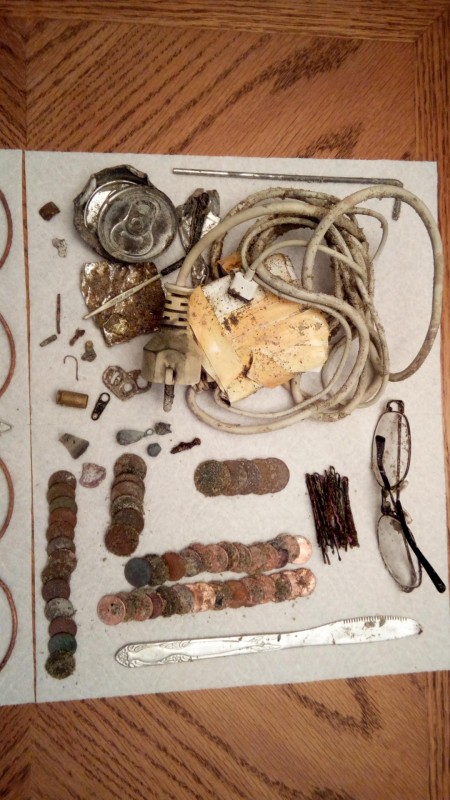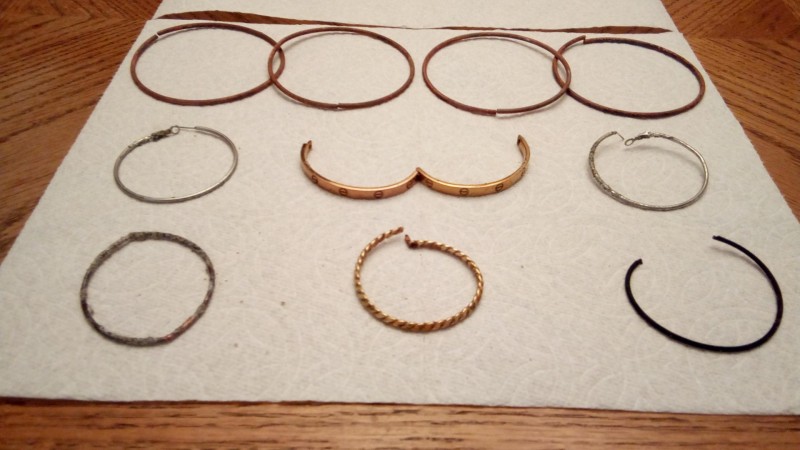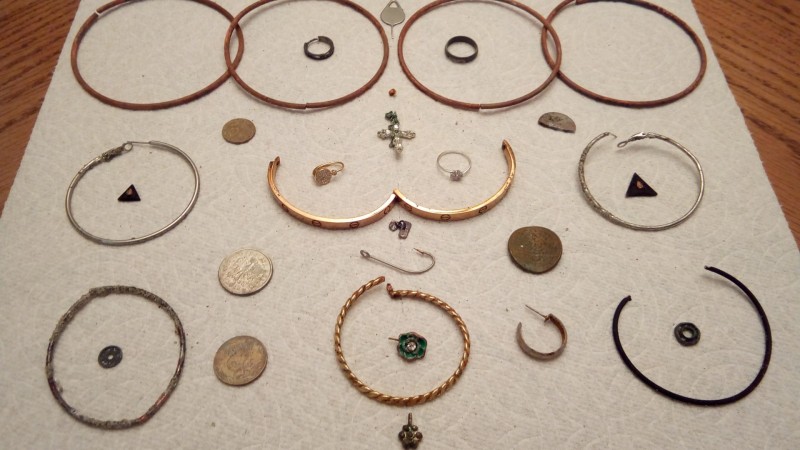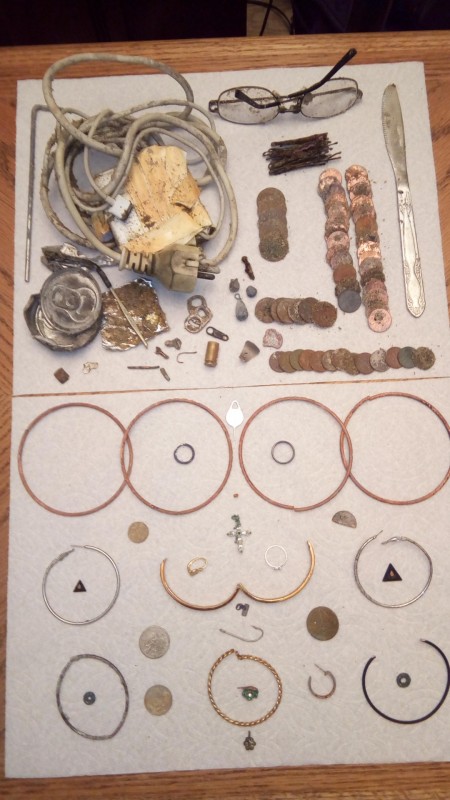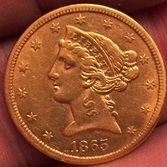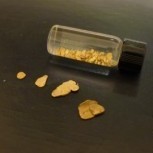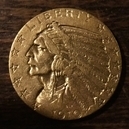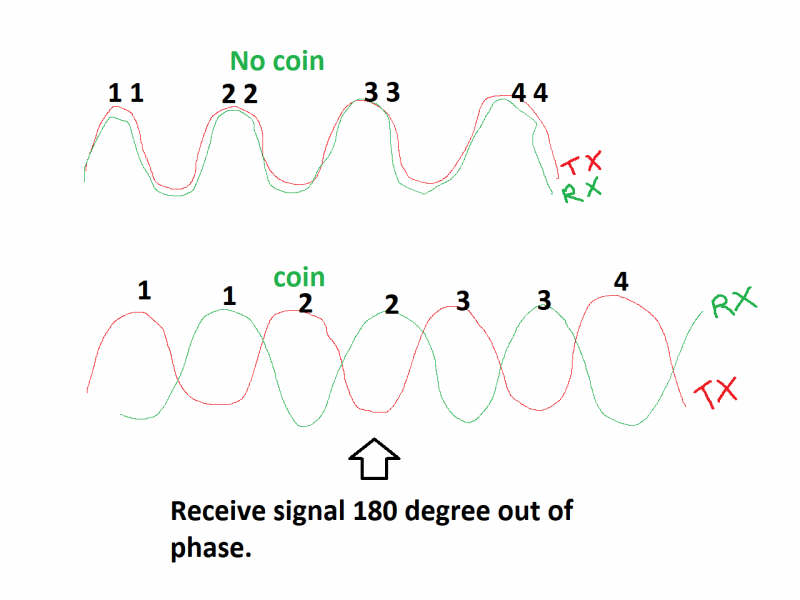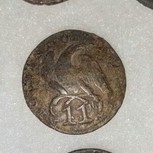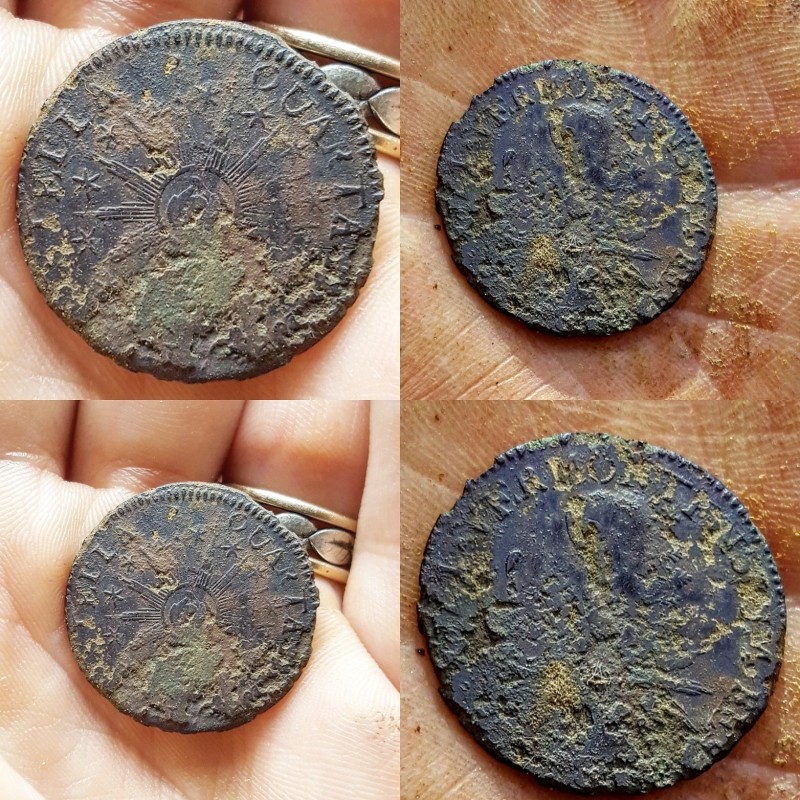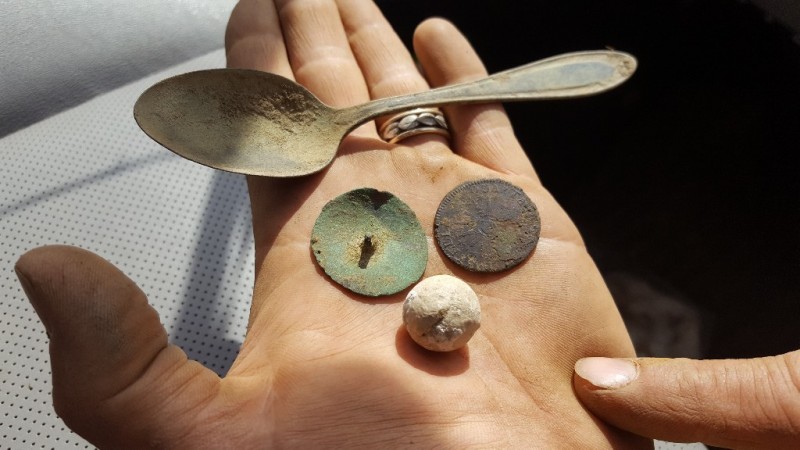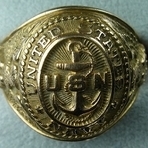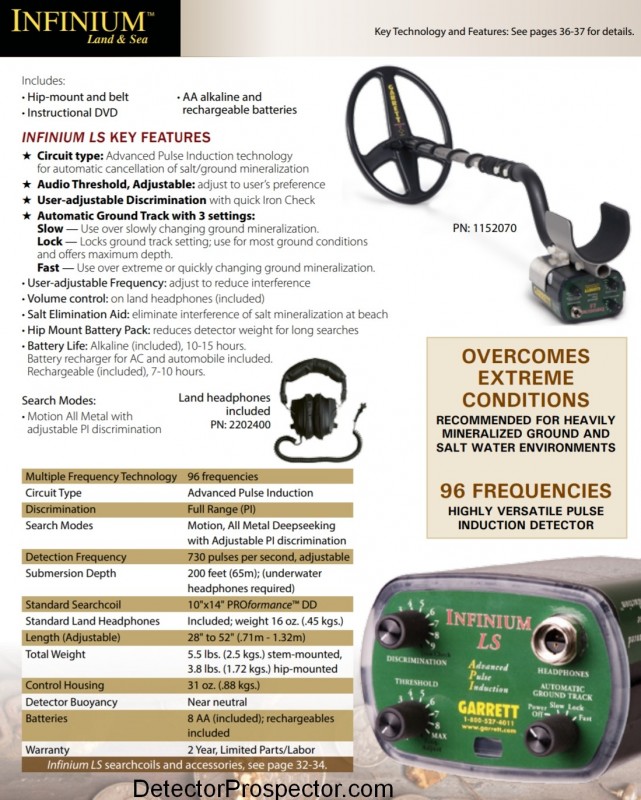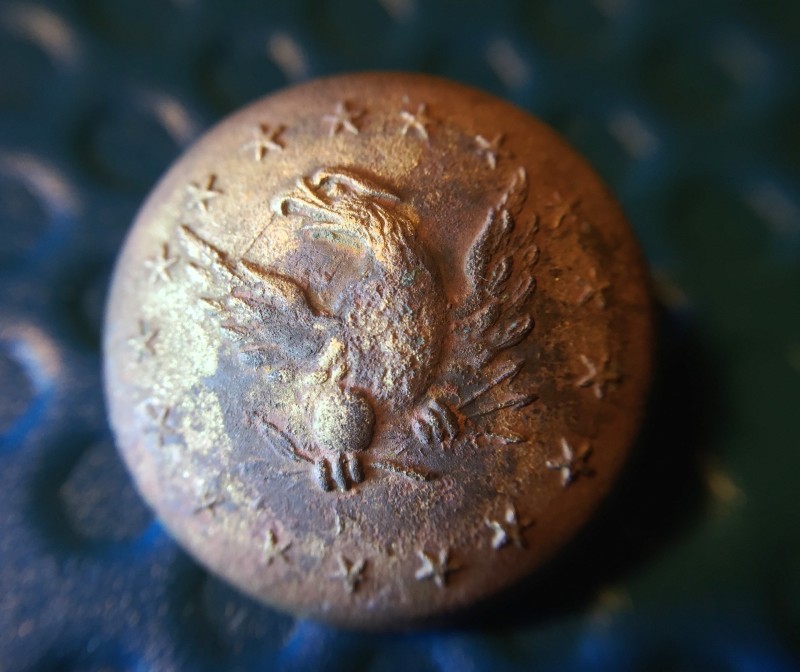Leaderboard
Popular Content
Showing content with the highest reputation on 12/28/2018 in all areas
-
Rudder is often stuck or unresponsive. But I see a lighthouse, hope it's the port and not the rocks.7 points
-
5 points
-
Thanks for the kind review Fred. I also i encourage all of the forum members here to subscribe to the I.C.M.J. and for the businesses here to support it with your advertising.5 points
-
Hey Everyone... Several months ago, I started honing in on nickel signals (Nox600 - 11,12,13,14) in addition to my high conductors and glad I did. I am digging more good finds at the mid tones. Check this out...Here are 307 nickels that I dug over past several months. I read somewhere that the averages are approx 200-250 nickels dug for each buff. Didn't mention V's or gold...only buffs.I guess I beat the averages... 307 nickels = 3 buffs, 3 v's, 1 war nickel, 1 18k gold ring and 1 gold buddha pendant... not bad huh? I didn't dig as much silver this year, cuz I only spent half the amount of time in the field from last year. Overall, adding nickel signals to my goals really kicked it up a notch. Merry Christmas everyone !!!2 points
-
This is something that has me a little perplexed, especially when a whole raft of opposition detectors from abroad are offering such an option on their detector platforms. How easy would it be to improve current popular models like the F75, AT Pro, etc with additional frequencies to make some US made detectors a more attractive proposition, or are we talking about the requirement for a completely new platform for this to happen ( too much cost for not enough return)? If just worries me when we see little or no response at all on trying to compete on the selectable frequency front. Some may say the market is already flooded with such detectors, though if you do not offer up an alternative to just single frequency VLF's, then customers may look elsewhere for detector platforms offering more flexibility/features for the money. Some of the selectable frequency detectors made abroad: Minelab Equinox (plus multi) Minelab 705 (coil change for different frequencies) Rutus Alter71 XP Deus/Orx Makro Kruzer Multi Nokta Impact Nokta Anfibio multi ...and many other lesser known Euro manufacturers with at least dual frequencies. It is evident that there are two distinct lines of thinking when it comes to producing a detector, either make one that has the capability of covering all or most fields of detecting (ie. prospecting, relic hunting, coin shooting, beach detecting), or produce several detectors, each with a specific purpose. The obvious downside is the sheer cost of owning a whole raft of detectors for specific purposes, something that used to be common place, though now not such an issue with the advent of very capable multi-use detectors suitable for low conductors right through to sub gram gold. Will be interested to see other views on the subject, have we seen the end of single use or specialist detectors, and whether multi-role/multi or selectable frequency detectors will rule going forward.2 points
-
Had a little winter hunt today at my local hunted out beach. This time I cranked the sens to 23 in hope to find some older stuff. Well, I found some gold! Came in at ID 10 - I really have to dig those lower numbers.. A 925 Ring again: A junk ring, 8,50DM, a foreign coin and some euro-cents. All in all better than expected. It's crazy how small things the 11" coil picks up.2 points
-
The US has one detector that runs both selectable and simultaneous multi-frequency: White's V3i (and sister VX3). According to Steve's review page it was introduced in 2009. Although (AFAIK) not selectable MF, both the Fisher CZ series from the 1990's and the White's DFX (also 1990's?) were among the pioneering simultaneous multifrequency detectors. Would it make financial sense to now put engineering/design/fabrication time into selectable MF detectors (that aren't also simultaneous MF)? The competition, as you've shown, is steep. It may be too late even for some of the recent releases such as the Makro Kruzer Multi and Nokta Anfibio Multi to make much of a dent in the market. (From what I've read they are excellent detectors, but selectable-ONLY MF may be yesterday's technology....) I'm hoping for new concept detectors from First Texas, White's, and Garrett. We don't need any more (sad) Tesoro stories.2 points
-
At the ICMJ we've decided to post a free issue of the prospecting and Mining Journal magazine on the internet for any new folks who are around to see what it is. (Also experienced prospectors who are wondering about the magazine). We have up to date articles about how to get more gold in your prospecting, legal issues and the best equipment out there for finding gold. If you have any interest in prospecting, this is the magazine you will the most learn from. I may be a little biased as I'm the assistant Editor, but on the other hand I've been getting this magazine since the late 1970s and its always been a lot of fun. Take a look, I think you'll be glad you did. I you want to subscribe, the subscription info is on the inside of the last page. Its worth not missing a single issue. https://www.icmj.com/resources/news-and-events/miners-news/free-online-sample-issue-392/2 points
-
If you want to understand frequency content, TX current gives a much clearer picture than TX voltage.2 points
-
Mining is huge here in AZ. Saw a bumper sticker a few years ago... EARTH FIRST... WE’LL MINE THE PLANETS LATER2 points
-
It's nether radio-like nor magnetometer-like. It's transformer-like. It's complicated. With a sinusoid TX (most SF-VLFs) the return signal from eddy current targets (non-ferrous) is a sinusoid at the same frequency. No distortion, no harmonics. Ferrous targets can distort the signal according to their B-H curves, but a SF-VLF doesn't consider the distortion. MF detectors don't use sinusoids, they transmit triangle/ramp looking waveforms which have a lot of harmonics. Non-ferrous eddy responses are exponentials which also have harmonics, and ferrous responses are distorted triangle/ramps. These can be processed in the raw (time-domain: BBS/FBS) or filtered (freq domain: CZ, DFX, V3). Equinox is direct-sampling so it's hard to say which method is used, but freq domain seems easier. Not sure what else you're asking. If you're using an oscope, then this is a triggering issue. MF waveforms are difficult to trigger on. Also, it's critical to look at the current waveform, not the voltage.2 points
-
We are all rooting for you Carl. The problem will be that you have your own marketing people, and they also like to obscure facts. The T2+ and F75+ were not exactly examples of clarity in marketing, and honestly left a bad taste in my mouth. Minelab sure is not a box full of saints, but there is enough nonsense to go around from what I see. We have Nokta /Makro selling a selectable frequency machine as multifrequency, ignoring industry convention. How many people bought an F75+ thinking it really was an improvement on the F75? How many people are buying a Multi Kruzer thinking they are getting a multifrequency detector? Minelab is not an isolated party when it comes to making marketing claims that obscure the facts. If I were you I would not worry. There are plenty of pragmatists like me who will gravitate to whatever works, regardless of who makes it, to win the day. Lots of people really are rooting for First Texas and waiting for whatever you are working on. It just can't be the F75++2 points
-
This was my first beach hunt in a few days because I had been out in the Rye Patch area over the weekend. While I was gone I understand that it had rained and some wave alerts had been sent to my email. Our area beaches get hit hard by detectorists but I know them pretty well and followed my intuition when I got there. We don't have a negative tide right now and there is a Santa Ana wind blowing so the new waves are very small. On my way 'out' I hunted near the waterline. There was very little to find. I walked about a mile or so with very few targets. There was a bit of a trough at the bottom of the hill (beach slope) but nothing seemed to be holding. I was thinking about leaving and I worked back in the direction from where I had come. Then I got a clue. The clue was the junk wire pack. It was completely buried in the wet sand and had a thin plastic bag around it. It certainly is an unusual beach find for me. This pack was at the bottom of the hill and just above it for about 6 feet or so was hard sand and just above that was about 10 yards of 'past wave' deposited sand. You need some energy to move targets and you need the right conditions for those targets to be 'grouped' and deposited. Some beaches will stay this way for a few days and some beaches will only keep targets for a few hours. I look for these pockets. I liken it to a crab crawl on the Deadliest Catch. Anyway, I went up into this area and found a hoop earring among the bobby pins, pennies and a few other coins. I was using the Nox 11 on all metal and I was digging EVERYTHING. Sometimes I skip pennies and bobby pin sounds but not last night. Then I was surprised by one of the silver hoop earrings and its mate was just about 5 feet away. Then came a copper hoop, and then another and all of them within 10 feet. They're all water tarnished. Then I got what I thought was a ring ... earring it turns out but then a stainless steel bracelet. Then another earring (GOLD) and finally a couple of silver rings (.925). I worked the patch with a grid pattern and it kept giving. I had had enough after 4 hours. A 'bad' beach had turned into the most hoops (10) I've ever found. I've been on beaches where I've found 5 chains in a session but they are as rare as this beach. You never know. Follow your clues. Mitchel1 point
-
This was my first hunt with my own modified Equinox program. Went through all the good jewelry I'd found and set the machine up to give one tone for the range of gold rings. Dug every nickel signal, didn't dig any gold rings but found one nice .925 ring that ID as a solid 31. Very unusual and it sparked me to dig. Of all the rings I've dug the majority range from 6-13 and most will read 13. Amazing machine, very enjoyable to hunt with.1 point
-
So today I visited my favorite gold beach. It did not comply with my requests What I did notice today is how the EMI from a very close train effects the performance of the Equinox. I was using Beach 1 and usually run my sensitivity at 22. Before, during and after a train passing I have to drop sensitivity to 20. It then quiets down enough to hunt....BUT, quiet as it is, I believe the depth is affected very much. I hunted from 8AM to 2PM (lots of train passes), as that is the bulk of the commuter and cargo runs. The second picture shows some clad. That was all the good targets during that EMI cycle (6 hrs.). When the trains start to have large gaps between runs, (from 2-4pm), and there is no major EMI emitted from the rails, then you can see in the first picture the results. Lots of wheats, some copper memorials, 2 war nickels, and 4 silver dimes and a silver quarter. Most of those coins were 8-12" deep. So today it seems that my depth and ability to hear the deeper targets with EMI present, is very compromised even though the machine runs smooth. I always new EMI cuts performance, but to see it first hand is an eye opener.1 point
-
There' s a fine line on having the right sensitivity to hear the deep, iffy targets. Also having some luck in hitting the target with the best, most responsive part of the coil helps. Add moisture, EMI and minerals into the picture and it's no surprise that we can find deep targets in places we pounded. You must have just had the best balance between low sensitivity and too much sensitivity. I've always pushed my machines into the red a bit, and like hearing a bit of chatter. But too much and it makes it harder to hear the real signal. I always thought the E trac was a great deep seeker. It really made old pounded parks come alive for many. For me, it did rather well on colonial cellar holes.1 point
-
Thanks David. I try to keep it even handed as much as possible. I go out of my way personally to post about all the brands whenever news of any sort appears.1 point
-
Carl how's that slow ship turning? I hope it's going to dock some time in 2019?1 point
-
Always enjoy Carl's knowledge inputs. Now I'm waiting on a true PI detector with a good discriminator or a time function to eliminate unwanted metal targets. "If man can think it, he can make it" with time. My TDI has found a lot of good targets masked with iron. And to add just a little, even gold that has eluded even the very best VLF's in the world.1 point
-
My Etrac was really hot on chatty days at a particular site, so much so that I did not want to perform a noise cancel. This is anecdotal at best, but there could be something to it, the one night I recall getting 4-6 good targets, (Silver coins, musket balls large cents etc.) this was after pounding the site for a good year previously. These wern't great shallow targets that appeared out of no-where, rather deep fringe targets that gave off questionable, yet positive non-ferrous ID. These targets would disappear if you tried to clean the machine up much. (Or tune out the EMI at that particular site it seems.)1 point
-
Welcome to the forum. We have a number of members here who detect the Yuma area - some nice gold gets found down that way!1 point
-
I guess there is a price to pay for stability. One of my biggest disappointments is by the time I really get to know a machine, they come out with a better one. Then I have to re-learn all the new ways to get maximum performance from it.1 point
-
1 point
-
Yes GB.... this is why I focus on the range of 11 to 14. The niks can come anywhere between those numbers both deep and shallow. If I have a deep 14 or 11 signal, I'm digging. 12/13 signals show up the most but you have to work in that 11 to 14 range nonetheless. By the way, I get a lot of old spoons too in that range. Yesterday, I dug a large One Shilling at a bouncy 14. This TID range has given me some good finds aside from the silvers and wheats.1 point
-
One of the beautiful things about gold is that even if tomorrow massive placer gold deposits were discovered on Mars, the closest and most readily accessible celestial body, the cost of actually going there to retrieve the metal, then bringing it back, would far exceed the value of the metal itself. Even if recovery was simply picking it up from the surface. Moving things into, and out of space, isn't cheap. Gold prices are in no immediate danger from off earth mining - not in our lifetimes!1 point
-
Ya,Tom Dankowski has recently written about EMI and Silent EMI, and how affects depth. http://www.dankowskidetectors.com/discussions/read.php?2,156756 Bryan1 point
-
Chase if I may, at least the way I picture it. The 2 halves of the coil are tuned so that they null out. If one half is oscillating at 10kHz, the second half is receiving @10kHz (effectively for this discussion) When you introduce a coin into the field, the coin has to wind up it's induction like a small fly wheel. This slight delay causes the signal to phase shift meaning the coin is not broadcasting in sync with the transmit side of the machine, it's delayed. That is what the machine is measuring. The machine says hey, this 10kHz is a little bit behind the 10kHz transmit signal. The amount that the signal is delayed equates to the amount of phase shift. This phase "angle" is part of how the discrimination works. (A full 360° phase shift would have the peaks and troughs of the signal line up again, just the receive side is one hump behind the transmit side. "Group delay" at that point I think.) In reality the receive side probably has a couple other phase de modulators, perhaps 90° apart to garner it's info. It probably accounts for permeability, angular freq and conductivity to come up with a number.1 point
-
I was hunting an old field and found an old button and after rubbing it with some vegetable oil to preserve it I went back to the same spot and found this old coin. I was shaking all over as I gently cleaned it off and rubbed it with a lightly oiled paper towel. I looked it up and it is a colonial Vermont copper from around 1785.1 point
-
http://www.dankowskidetectors.com/discussions/read.php?2,157902 88junior on the Dankowski site identified these as matrices for a linotype machine. They are essentially molds, each representing a single letter that are assembled by the machine into lines of the desired words. Molten lead is then used to form the type from the matrices (called a "slug"). The type setter can then assemble whole lines of type at a time instead of each individual letter one at a time. The funny thing is that my grandfather operated a linotype machine for a living from the 1930s until he retired in the 1970s. He even made me a slug with my name on it when I was a kid. I did find letters in the recessed areas. Thank you to those who took a look or responded.1 point
-
You sure can get a guy all fired up. Those Seated Buttons are amazing and to catch it on video is even more rare. Some of the early seated dimes and actually larger in size than the later dated seated dimes. I think they will read a little different. too. Hats off to you Cal_Cobra and yes I like that glass trade bead and the cool black glass cuff link. I feel the exact site of your finds were a seamstress shop. Yes the Multi IQ technology of the Equinox can penetrate and see objects better than most other machines when in burned areas. Thanks for sharing.1 point
-
"Some stories are worthy of being told more than once. There are countless stories about lost or buried treasure in Nevada history. Most of these are legends that might or might not have any basis in fact. The following story, however, is one of the rare cases where a real treasure was found, when there was no previous knowledge it even existed." Full Story Here1 point
-
This is all based on an assumption people make - that more frequencies are better. Are they? Why? Other than advertising, what makes anyone think that? There is no reason to compare items at close frequencies. Comparing 10 khz and 12 khz is a waste of time and processing power. What you want to do is compare the targets and ground at a few widely differing frequencies. That way you see what happens that is different at say 4 khz and 32 kHz. That difference or lack of difference gives you extra data to work with. And as Minelab points out in the article about Multi-IQ the more interesting question is how few frequencies are needed to get useful information. And that seems to boil down to two or three. "'How many simultaneous frequencies?' you may ask, wondering if this is a critical parameter. Minelab has been carrying out detailed investigations into this in recent years. Just as you can color in a map with many colors, the minimum number to differentiate between adjacent countries is only 4 – a tough problem for mathematicians to prove, over many years. Similar to the map problem, it’s perhaps not the maximum number of frequencies needed to achieve an optimum result, but the minimum number that is more interesting. When it comes to frequencies in a detector, to cover all target types, how the frequencies are combined AND processed is now more important, with the latest detectors, than how many frequencies, for achieving even better results." My assumption always when dealing with frequencies and what is processed versus what is transmitted goes like this..... Manufacturer claims multiple frequency operation, simultaneous or near instant sequential, I don't care. They state a number of frequencies. I then assume that out of the frequency range mentioned, that at least two or more frequencies are being received and compared at the processing level to justify the claim of multifrequency. Just exactly what frequencies are being processed and exactly how they are being compared.... I do not expect any company to tell me other than in vague terms. That's it. That way I stay calm while others try and divine the magic. And with that I leave the subject to better minds than mine.1 point
-
The why of it is simple - you are reading things into the careful gaps Minelab leaves in their advertising. I am not reading it the way you are, and so I am not offended because I do not feel I am being mislead. You are reading something else into it and feel unhappy because you feel you have been mislead somehow. It all boils down to debating perceptions of what you think the advertising means as compared to what is really going on under the hood. Since you don't 100% know what is going on under the hood, you just don't know. All detectors are transmitting on at least one primary frequency and many harmonic frequencies. This can be determined with a scope and if you count harmonics it is just a matter of picking a number you want to advertise when it comes to transmitted frequencies. You have no idea how many are being processed unless you know the processing algorithms. This back and forth with Minelab and the others has been going on for years. Garrett picked 96 frequencies for a Garrett Infinium ad as a direct poke at Minelab. How many people thought the machine was really transmitting and processing 96 frequencies based on the ad? It is all about transmitted because a PI detector does not receive and compare frequency information. Meaningless fluff, an industry insider joke. Get your 96 frequency detector right here.... Garrett Infinium ad - 96 frequencies! Carl Moreland weighed in with his frustration on another thread. White's even gave room over in the V3i manual, probably with Carl's input, to comment on the situation. From the White's V3i Owner's Manual, page 6: "There is much confusion - some of it deliberate - over how many frequencies a detector actually uses, and whether multiple frequencies are truly better than a single frequency. What defines a multi-frequency detector? What do multiple frequencies really do for depth and discrimination? A multi-frequency detector is defined as one that simultaneously—or, in automated sequence— transmits, receives, and processes more than one frequency. Some detectors have the ability to operate at one of several selectable frequencies, but they still are single frequency detectors because during operation they can only transmit and process a single frequency. The same is true of detectors that have a control to slightly vary their operating frequency to minimize interference; even though they have the ability to operate at many (slightly) different frequencies, they are fundamentally single frequency designs. Currently, all multi-frequency hobby detectors run their multiple frequencies simultaneously as opposed to sequentially; they are all characterized by having multiple processing channels in the receive circuitry. Therefore, a 2-frequency detector will have two processing channels. Spectra V3i has three independent processing channels; it is a true 3-frequency detector. This all sounds easy, so where is the confusion? It turns out that (currently) all multi-frequency detectors create a transmit signal that is composed of digital waveforms which are designed to produce peak energies at the desired frequencies. As a side-effect, these digital waveforms also produce undesired harmonic frequencies. Lots and lots of harmonic frequencies, 10’s or even 100’s of them. These harmonics have no useful energy and are not part of the signal processing. So while we can claim to transmit many, many frequencies, we cannot claim to process or use them. Therefore, we could easily claim the Spectra V3i transmits 17 frequencies, or 28, or 39, or 55—we could get plain silly with this. And such a claim would be true, technically speaking, but since all those extra frequencies are not actually used, it would be misleading to make such a claim. White’s chooses, instead, to claim the number of frequencies we are actually using and processing. It may not sound as impressive as a 55-frequency detector, but it’s honest and accurate. Pulse Induction (PI) detectors also utilize a digital (pulse) transmit waveform, so they transmit a tremendous number of harmonic frequencies as well. So is it fair to include pulse induction as a multifrequency technique? Not really, because PI detectors process in the time domain, not the frequency domain. So even though they use broad-band signals, they are not frequency-based detectors at all. Calling them “multi-frequency” is simply another attempt to confuse the consumer. Once we get beyond the marketing hype, the real question is: What does multi-frequency do for depth and discrimination? The truth is, any time a detector is simultaneously transmitting more than one frequency, the transmit energy must be divided amongst the frequencies. Therefore, a single frequency detector can usually squeeze out slightly more depth than a multi-frequency design at that certain frequency. But this is an advantage only at one frequency, which tends to favor only a narrow range of targets." These are old debates going back to Minelab BBS and it’s 17 transmitted frequency claim. I reference it all in my discussion at Selectable Frequency And Multiple Frequency Anyway, interesting subject for armchair engineers and armchair attorneys. Hopefully you all get it sorted out while I am out metal detecting!1 point
-
Interesting read. Makes you wonder how in the heck anyone could just let that go without telling even a one friend or family member. Maybe they died suddenly? Makes me wish I had searched my grandparents house better before my mom and uncle sold it. They were self employed ran a restaurant and were known to hide money. My uncle swears he went through everything strick1 point
-
Not really FBS3. Focusing on the frequency combos is only half the story of Multi IQ (perhaps even less than half). The real focus should be on how the received signal is processed, and ML is not spilling the beans on how they do that. Frankly, anyone who relies on ML's or any other manufacturer's marketing stuff (and that INCLUDES the stuff put into the instruction manuals) as their sole source of technical information about how detectors work without doing any other research are doomed to fooled. It helps to know certain technical characteristics of a metal detector (such as operating frequency) and how a parameter like that affects your ability to find certain types of targets and the difference performance characteristics of different types of coils, but beyond that, what really matters is learning how your machine behaves and the language it uses and that simply comes from getting a lot of swing hours in and digging junk as well as keepers. I don't blame ML's marketing department they need to balance the complex technical truth against conveying concepts in a manner that can be understood by non-engineers while trying to sell detectors at the same time. The result is usually something that has some underlying truth but a lot of artistic license, as well. I mainly ignore it unless I want a chuckle and use my knowledge of engineering and physics to throw the BS flag when necessary, otherwise, I just go out and learn the detector by swinging it and don't lose sleep or even get irritated over 2 vs. 5 vs.28 simultaneous frequencies, quite frankly.1 point
-
Ditto Jimmy.... My way of looking at gold "value" is much the same. An ounce is always an ounce. Back when gold was $20/ounce it took approx. 30 ounces to buy a bare bones pickup truck...today it takes approx. 30 ounces to buy a bare bones pickup truck....nothing has really changed as far as the "value" of gold...???? jmo...….1 point
-
Steve you'll just have to watch the video to find out There was one main area of about a 12 foot diameter that the bulk of them came from, and interestingly once you got down around 7-8" it was scorched earth and that's where the coins where. A few pieces of jewelry came from the same scorched earth and some buttons (old 4-hole buttons). About 4-5 of the coins where further away, maybe 10-15 feet away scattered in various directions. Interestingly (Steve perhaps you can comment on this), we have had a multitude of detectors on this same patch of earth - Explorer2, Tesoro Silver Sabre, F75, Racers, Multi Kruzer, etc., and none of them even detected a single coin. I could see if they missed most of them, some of them, but to not even detect one out of twelve is a complete mystery. I suspect that the scorched earth caused the detectors to see everything as iron, and we skipped them. If I had more time, I should've went back to my vehicle and grabbed my Kruzer to see how the ground sounded, but it's been over that patch of ground on two different trips now and didn't get any of the targets you'll see in the video that the Equinox was able to get, some deep, some not so deep. So the Equinox is doing something completely different then anything else we've had there.1 point
-
Gerry I was able to clean that one piece Eagle button up and it was ID'd in the Alberts book as an 18teens - 1820 U.S. Militia Eagle button! Here it is after cleaning it, and it came out beautiful, even has some original gold gilt left: That long piece broken at the screw hole did turn out to be a trigger guard from an old rifle. Thanks for taking a look, I ended up having a great hunt on my little road trip last weekend, I'll make a separate post on that one ? -Brian1 point
-
Agree with that. I have wanted to do this owning two Equinoxes and I intentionally kept one rolled back to the original firmware. The difficulty for me lies in the fact that I only have one 6 inch coil and two different shaft systems (Anderson and the OEM shaft) so even switching back and forth with a dedicated lower shaft is difficult. The best I can do right now is compare the two with the 11" coil. I have done that and am analyizing the video I took of that test to see if I can come up with some conclusions. Thing is, it won't shed much light on falsing because I did the comparison testing on neutral beach sand because I was looking for target ID stability, depth, and audio quality. Maybe I can run some tests with the 6" before things freeze up.1 point
-
I think a lot of people were thinking along these lines but for whatever reason (on my part, lack of guts for one thing but also lack of confidence in my detecting ability/experience) kept it from being said. Well stated, Steve. Actually the same holds true (IMO) in many of the reported differences in the two firmwares we've been reading from day 1. I'm still unsure I can see/feel/hear any differences between the two other than the depth indicator change (which I hardly ever used before nor since). I certainly have my own perception of (minor) differences but haven't done the diligent testing required to be able to report with confidence. One thing this thread has emphasized to me is how difficult it must be for engineers to 1) sort through customer bug reports, and 2) apply a change which addresses concerns without messing up something else. On the Equinox there are so many different combinations of settings made available to the user and and way more (with software change 'knobs') to the engineer. I can see why it's apparently the exception for manufacturers to issue software upgrades. (This seems to be deja vu when compared to the Fisher F75 issues First Texas had to deal with, and customer complaints afterward saying it was better before the change.)1 point
-
Building a 5-frequency metal detector would not be difficult, and there are plenty of processors with more than enough horsepower. But the transmit power gets divided amongst each frequency so you lose depth. There are tangible benefits to 2 frequencies. There are additional tangible benefits to 3 frequencies. There are almost no tangible benefits to more than 3 frequencies. That is a correct assumption.1 point
-
Start driving Chuck - Carl will be waiting for you along with your new Fisher CZ-3D (Multiple-Frequency transmit, Dual Frequency Processing VLF Search 5 KHz and 15 KHz)1 point
-
That is a fair statement, and if what I have to compete with is performance, I am happy to do so. But some people buy into the gee-whiz factor more so, and if I come out with a 3-frequency detector they're gonna ask why I couldn't do 5, or 17, or 28 frequencies. Things no one else has done, either. The only way I can compete with false claims is to trump them with more false claims of my own, something that never benefits the end-users, and personally offends my sense of ethics besides. Instead, I'll just state the truth and do the best I can.1 point
-
Yes. I used a magnetic field probe I designed & built. There are at least 2 threads on Geotech discussing all this, including scope pics.1 point
-
I guess when you ask if the day of single frequency has passed and it turns into a debate about the technical details of multifrequency that kind of answers the question. I had one engineer tell me he would rather saw his leg off than have to work on another single frequency detector. Boring....... Whatever, I will let you all sort out the technical details. I am just happy I lived long enough to see this phase of the technology kicking in. The next few years will be interesting.1 point
-
El Nino, looking at the TX voltage on an MF detector is next to useless, you gotta look at the TX current to see what is going on.1 point
-
1 point
-
If all Equinox brought to the table was multifrequency it would not be selling like it is. It it light weight, waterproof, built in wireless, and yes, multifrequency... all that and more for a killer price. What makes Equinox different is the complete package at an incredible price. The number of frequencies, how they are employed, etc. is all a sideshow. It is as simple as the features for the price, and the fact that the machine actually does perform exceedingly well for the price. The CTX versus Equinox debate for example almost always ignores the elephant in the room - $800 vs $2500. V3i? I have one and think highly of it for some uses, but stick one under saltwater and it does not work so well. What if the Garrett AT Max had offered multifrequency? They would have beat Minelab to the punch. What if the Fisher CZX had actually happened as planned? What if White’s had stuck the V3i in the MX Sport package first? The fact is there was a large pent up demand for a detector like the Equinox that has been clearly expressed on forums for years, and Minelab delivered first and at a price that borders on predatory. It will be very difficult for the competition to compete at that level, even if they can overcome both the technical and patent issues. That all said single frequency detectors will be around as long as I am alive at least. They do many things more than well enough for most people. The danger from a manufacturer standpoint is that anyone can make a good one now, and competition will demand a race to the bottom in retail pricing. Betting your company’s future on how cheaply you can make a single frequency VLF is a tough road to head down. The low cost manufacturer wins and everyone else faces a margin squeeze. Only on forums do people really care about all this under the hood stuff. As a past retailer I can tell you all most people care about is what the detector will do for a price and not how it goes about doing it. The hype and marketing only gets you so far, as in time people do figure out what works and what does not. Like it or not there are some things multifrequency does better than single frequency and so a large segment of the established user base is demanding it. The masses will just follow along. It really is that simple.1 point
-
1 point
-
I keep getting requests for at least one forum with a looser format and in particular a place where people can make "that first post" and introduce themselves. So here it is. Meeting people and getting to know them often means general chit chat and such. Anything is pretty much ok here but more than ever it is important people abide by the forum Prime Directive - treat others with decency and respect. Past history and baggage from other forums is not allowed here so just leave it at the door, or do not enter. This is the forum most likely to see new members and so all "Forum Info" posts are also archived here for those who want to know more about how the forum software works, etc. Other than that - enjoy! Now a little history for those totally new to the forum. I used to hang out on all the other forums. The problem over time is I kept bumping into rules. No mentioning certain brands or dealers for fear of offending sponsoring dealers. That will never happen here as the forum members come first. The one that really irritated me was no links to all sorts of things, like other forums. Here, if the subject matter is relevant, please link to it! No silly "Google it" games etc. And then there are the trolls. People who just like to stir things up. Childish and rude people. Tons of off topic garbage to wade through to find decent information. Etc. I just got tired of it all because over time it all got worse as forums became more commercial. I started these forums to escape all that and with the goal of attracting like minded people who are also tired of all the nonsense. So the main thing here is very, very simple. With the possible exception of this forum, keep discussions on the particular forum subject matter. Be a decent person and better yet, try to help others. On topic, be good - it really is that simple here. New Member Signup - Click Here! Lost Password - Click Here! Forum Tips & Tricks Advanced Search Tag List/Index1 point



.thumb.jpg.ac5e8ee36e43bcab745dbc623fcf1874.jpg)
